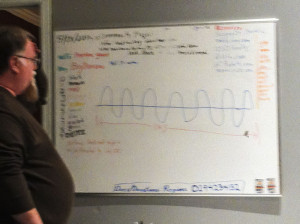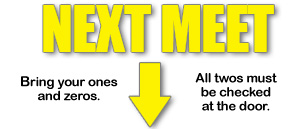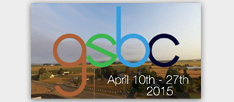Before our regular club gathering on a fairly warmish winter evening, poozr provided barbecue and sides (thanks poozr!) and all settled in well fed for the discussion.
The meeting opened with a moment of silence for the individual Radio Shack stores already lost. We had lost our local independent Radio Shack last year, a central point of Inglewood history for forty years. The news that Radio Shack was declaring bankruptcy and closing a significant part of the stores was a final blow in the story of a familiar neighbor in long decline.
Mayhem has been following the software defined radio thread on hackaday.com with interest, so he thought it was high time to talk with the group about radios and radio circuitry.
There was some talk about zigbees and miwi specifications before he settled down to the nitty gritty theory and history, starting with the name of James Clerk Maxwell, who first proposed the electromagnetic radiation theory, which was proved in the laboratory by Heinrich Hertz with his work on production and reception of radio waves. Terms soon covered the white board, including ‘oscillator‘, ‘carrier frequency‘, ‘amplitude modulation‘, ‘frequency modulation‘, ‘single side band‘, and ‘Vestigial sideband (VSB)‘.
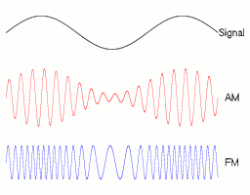
The simplest receiver is the type that requires no batteries. The professor sketched out a simple crystal receiver using a minimum of parts. The receiver’s detector morphed over the years from a stiff wire probing the surface of a block of galena (lead ore) to man-made diodes of different flavors. One of the oddest of those in history has to be the WWII “foxhole radio” circuit that used a blued razor blade as a detector. A modern experimenter would probably find a germanium diode is easier to source, as blued razor blades haven’t been commonly made for years.
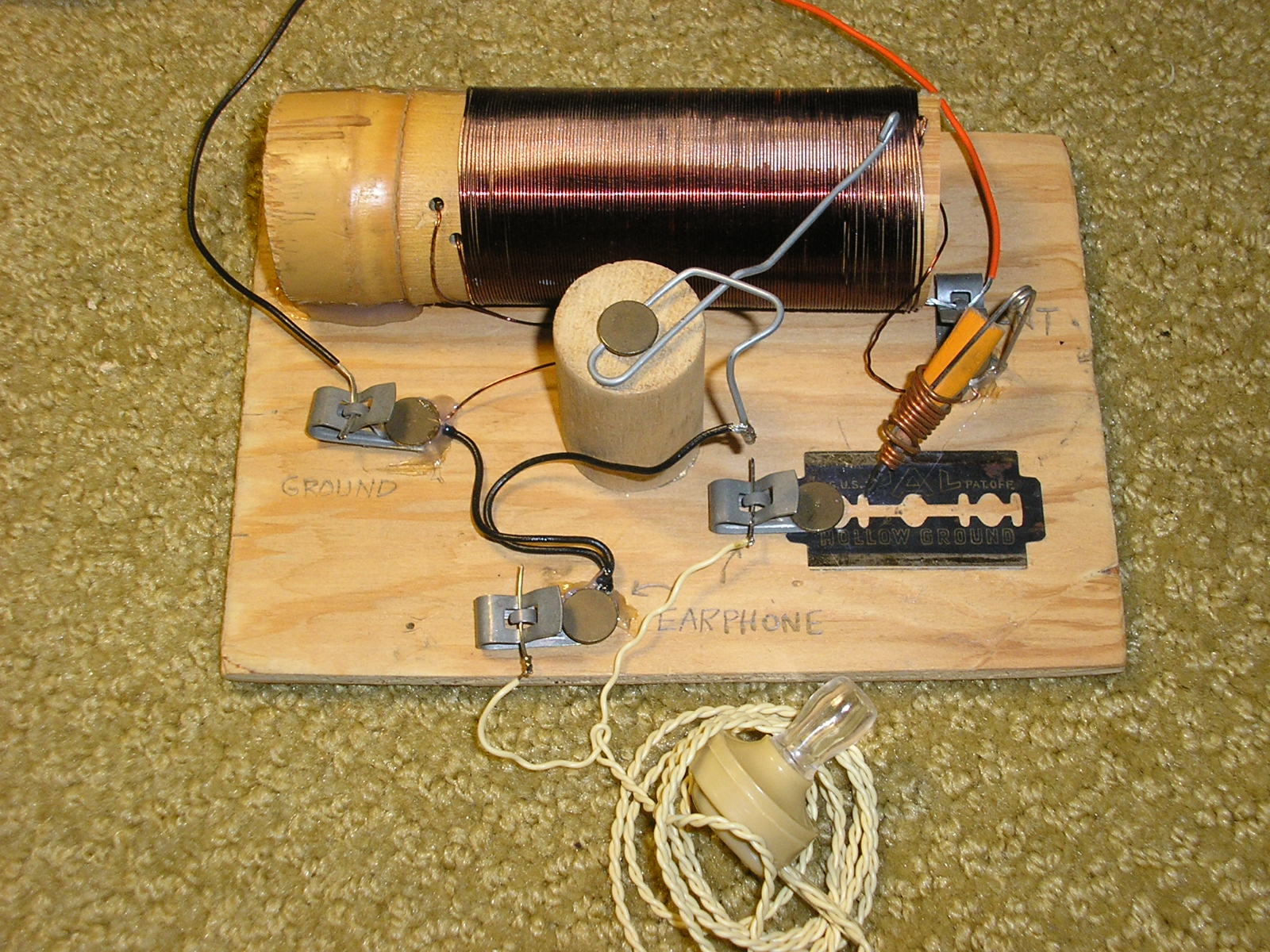
One of the hobbies that relies heavily on this knowledge is that of Amateur Radio, and so the discussion included that of lower and upper sideband in ham radio, carrier suppression, beat frequency oscillators, and some examples of “amplitude” and “wavelength” so the assembled could visualize the concept. The distance a signal can travel is based on various things: frequency, the size of different antennas: For instance, the wavelength of WSM, 461.54 meters if the math was right, is longer than the tower is tall!
Amateur radio discussions ended with Mayhem’s question: “Who’s getting their ham license?” and “Who’s going to Dayton?” Dayton Ohio, the site of the largest hamfest held in the country, is held during early Spring. This year’s ‘fest, May 15-17, is early enough in the year that it makes it tricky for those still in school to attend, as it is very near exam week.
–The radio diagrams continued, drawn in the traditional style with the left side depicting the signal received from the air and the right side addressing the audio amplification section– the “finals”. The difference between block diagrams and schematics was clarified.
TRF sets: Early Tuned Radio Frequency sets had three capacitors to tune for maximum strength, with legends usually from 0-100 each. The log notes (positions of all three dials for strongest reception) of a listener’s favorite radio station looked like a safe combination. Tuned wrongly, you would hear nothing while your neigbors would hear your set warbling over the stations they were trying to listen to, hence the old slang name for the sets, “bloopers”.
The history continues with Reginald Fessenden, a Canadian who invented the beat frequency oscillator– therefore the father of the heterodyne circuit–was the first to produce voice and music transmissions through a huge Ernst Alexanderson alternator, probably witnessed only by a handful of wireless shipboard operators. Previously all transmissions had been the dots and dashes (buzz and buzzzzzzzes) of the telegraph messages transmitted through continuous wave telegraphy.
Radio history is studded with great inventors like studly Edwin Howard Armstrong, who gave us superheterodyne reception and frequency modulation, and had his own group of radio stations called the Yankee Network before succumbing to despair over the skullduggery and superior Multi Lawyer superpowers of Brigadier General/Corporate Fatcat/FCC Lobbyist/Head of the Borg David Sarnoff of RCA.
Back to technical things: the stage-by-stage block analysis of a radio followed, RF, IF, and AF, and the rule of thumb that I.F. frequencies were 455khz and 10.7 Mhz. Questions answered included Why local FM is better listening than AM, including avoiding the interference that Amplitude Modulation suffers from, natural and man-made: everything from lightning to unshielded ignition systems in automobiles.
The FM invention was championed for mobile communications by the Fred Link corporation among others.
dirtworm then came in, bearing electronic giveaways a-plenty from a closet cleaning. He also brought stories and show-and-tell artifacts from the distant past: a time when a couple of young men were interested in early computers, all things electronic, but especially the prospect of being able to speak to a wider audience…
His stack of blank QSL cards from an unlicensed station was mute testimony to local radio broadcasts made over a quarter century ago that made their mark in history. Pioneers in their own right, two young men flew the black flag and broadcast on the clear channel of 7370 in the Forty Meter band under the call sign WXOR, named for the Exclusive Or function in boolean logic in a fit of terminal nerdiness. (At this point, someone in our group not really up to speed yet looked at the WXOR logo and asked “Did you have to apply for that?” which produced raucous laughter.)
The Reagan-era broadcasts started with Edgar Winter’s “Frankenstein”, and the program material’s eclectic offerings ranged from cassettes of The Cars Greatest Hits to those of Monty Python, as well as including a (pay phone) telephone number to call the freebooting duo. The equipment was simple and portable: A microphone keyed, sitting on the dashboard speaker, to pick up the output of the truck’s cassette deck; two gooseneck microphone stands on a board, a genuine Radio Shack mixer, and a dipole antenna to attach high up on one or another telephone pole in various locations, including off of Ben Allen Road where the TBI building now stands, and a phone booth at Sixteenth and Ordway in the modern-day Hipster City area of East Nashville. Within the fifteen minutes of the beginning of their maiden broadcast, the story goes, the phone rang, startling them both. One hesistated, then excitedly sprinted toward the booth, discovering their very first call was not local, but from a man in New York! Prepared for this eventuality, they sent him a QSL card, confirming his contact, signed not with their names, but their handles from the metal detecting hobby, “Captain Bottle Cap” and “Pull-Tab Hunter.” Some time later, they discovered a mention of the station in the December 1987 issue of the largest shortwave listening magazine Popular Communications! THEN, the NEXT month’s issue included an image of their QSL card and an article about the station. When an associate stopped by the local Radio Shack with photocopies from the 1989 Pirate Radio Directory, they knew they had made it to the big time. The veterans of that campaign talked about the relative merits of the modern movie made about pirate radio which was based on such real life stations such as Radio Caroline. There seemed to be a split decision as to whether the movie was “good” or “just ok”, which is worth listening to from Those Who Lived Those Times.
He also brought artifacts from his product called Microbay, software that several of the YMW founders had an early part in. Microbay started as a program to handle the inventory of Brinks Radio Shack on Gallatin Road (a couple of hundred listings on the web still exist which include “Microbay” and the Gallatin Road address-N.) Corporate caught wind of it, and soon dirtworm was being invited to speak at Radio Shack’s annual corporate meeting–quite an accomplishment for a man in his early twenties. The product went on to be the inventory software for a variety of businesses, including various mom and pop shops, a few Tru Value Hardware Stores, and inevitably several hundred Radio Shacks. Along with the development, many other aspects were locally sourced within the senior members of our group, including the packaging and printing and such fine details as the cover art. One of his exhibits Saturday night was a ream of fanfold tractor-feed paper, which was a printout of the application code from 1990.
dirtworm did quite a bit of that kind of work, and he talked about the pre-internet (as we currently know it) days of the BBS, or bulletin board system. You’d dial in to one to take or leave files. Each caller had to have his own (then-expensive) line and modem; dirtworm remembered it was kind of big time to have (as he did) three lines and modems, so three different people could use his BBS simultaneously (!) He also had TWO CD rom drives, each able to contain 640 meg of information. The memories rolled in in waves:
“The Microscope BBS users log, download and upload call in access”
Fidonet:
The Nashville Exchange was the first one to get true live actual internet. “I had to set up a ppp account, Bear was doing all of the tech mess…”
“One of the cool things you could do on a bbs is leave a message or a file. Late at night the bbs would dial another bbs, and that another, and so on, and you could send a message to *california* if you wanted to.”
dirtworm asked if Mayhem remembered the Words of Wisdom game you could play on the bulletin board…. “Was that a bulletin board system called Mustang?” –No, no, that was way way later, something else…. I wrote that into what he needed… BBs 80 bulletin board system… And this (another exhibit) is the manual to SUperUtility, that was some TRS-80 TRS-DOS to doing that… And Here is the code to Service Manager, which is what we used to keep up with the shop downstairs, items in, parts used, tickets running long, in Ed Bixler’s day, “Oh yeah?, I have B’s ICOM 02-AT” Oh yeah, those were made to pick up a certain set of frequencies and it was bulletproof on em, versus ….”
…When the reminiscing ran its course, the final order of business settled on the balloonchallenge.org project YMW is doing. The transmitting module was checked with a two meter rig, and the final few, less-technically minded members of the group were assisted in signing on to the balloonchallenge.org website.
-N8

